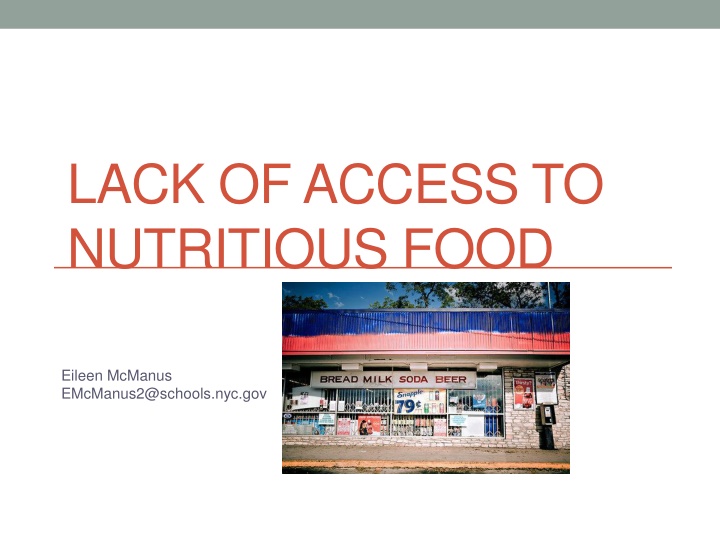
Influencing Policies to Improve Access to Affordable Nutritious Food
Addressing the issue of lack of access to affordable and nutritious food in certain communities, particularly in low-income and rural areas, by exploring how schools can influence policies to help students access healthier food options. Steps of the Public Policy Analyst (PPA) framework are outlined, detailing the process of defining the problem, gathering evidence, identifying causes, examining existing policies, developing new solutions, and selecting the best solution. Various factors contributing to the lack of access are discussed, such as limited availability of healthy options, transportation challenges, and low household income. The content also describes an interactive activity to engage students in discussing and reflecting on their beliefs regarding healthy eating and access to supermarkets in different areas.
Download Presentation

Please find below an Image/Link to download the presentation.
The content on the website is provided AS IS for your information and personal use only. It may not be sold, licensed, or shared on other websites without obtaining consent from the author. If you encounter any issues during the download, it is possible that the publisher has removed the file from their server.
You are allowed to download the files provided on this website for personal or commercial use, subject to the condition that they are used lawfully. All files are the property of their respective owners.
The content on the website is provided AS IS for your information and personal use only. It may not be sold, licensed, or shared on other websites without obtaining consent from the author.
E N D
Presentation Transcript
LACK OF ACCESS TO NUTRITIOUS FOOD Eileen McManus EMcManus2@schools.nyc.gov
How can our school influence policies that can help students access affordable nutritious food? Problem: Certain communities lack access to affordable and nutritious food. This is especially true for those living in low-income communities of color and rural areas with limited access to grocery stores. These areas are often called food deserts. Location of the problem: United States Three undesirable social conditions : Diseases (diabetes, heart disease, high blood pressure, high cholesterol. Low productivity Low self esteem Step 1 of the PPA: Identify the Problem
Steps of the Public Policy Analyst (PPA) Define the Problem Gather the Evidence Identify the Causes Examine Existing Policy Develop New Solutions Select the Best Solution
Identifying the causes of lack of access Healthy options are less available- Instead of supermarkets or grocery stores, these poorer communities often have lots of fast-food restaurants and convenience stores. In addition, stores in low-income communities may stock fewer and lower quality healthy foods. Lack of available transportation- Public transportation to supermarkets is often unavailable. It is often a far distance to get to supermarkets from low income communities. This makes it hard for some people to maintain a healthy weight for themselves and their families Low household income - When available, the cost of fresh foods in low-income areas can be high. Too often, unhealthy foods cost less money. Step 3 of the PPA: Identify the Causes
Examining the current situation The following signs are posted throughout the room: Strongly Agree, Agree, Disagree, Strongly Disagree in separate corners of the room. Walk to the sign that most strongly represents your feelings or beliefs about the following statement: It s easy to eat healthy food Talk with the other students who chose to stand by the same sign and discuss your position. Choose a recorder to write down the thoughts of the group members.
After 5 minutes, one group at a time, share your group s position with the class. If you agree more with another group after hearing their position, feel free to switch corners. If you switch corners, be ready to defend your choice.
Examining the current situation continued Now, Walk to the sign that most strongly represents your feelings or beliefs about the following statement: Supermarket chains should be forced to build in urban and rural areas, not just suburban areas Talk with the other students who chose to stand by the same sign and discuss your position. Choose a recorder to write down the thoughts of the group members.
After 5 minutes, one group at a time, share your group s position with the class. If you agree more with another group after hearing their position, feel free to switch corners. If you switch corners, be ready to defend your choice.
What can be done to resolve this problem? Brainstorm ideas with your elbow partner on what can be done to resolve this issue of lack of access to affordable nutritious food. In your HOME In your SCHOOL In your NEIGHBORHOOD In the UNITED STATES Step 5 of the PPA: Develop Solutions
Develop Policy Group 1 Design a presentation to a large grocery chain that would persuade them to build a supermarket closer a food desert you have selected. Information could be about the community itself, including the number of children; general health/wellness statistics; the benefits to the supermarket of building here; and common good that a supermarket can bring to a community.
Develop Policy Group 2 Develop an idea, other than a standard grocery store/supermarket, that could give those in a food desert access to healthy and affordable food. Design a poster describing your idea, then write a one page proposal describing what would have to happen to make the idea a reality, any related costs and why you think it would work in this community.
Develop Policy Group 3 Design an education campaign (poster, video, etc.) to help those who live in a food desert understand the importance of eating healthy foods and tips for accessing healthy foods and selecting affordable healthy foods when on a budget.
